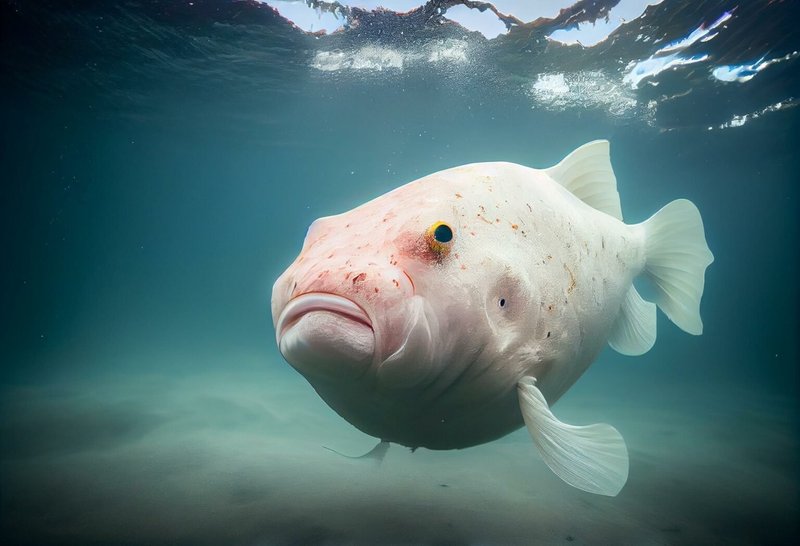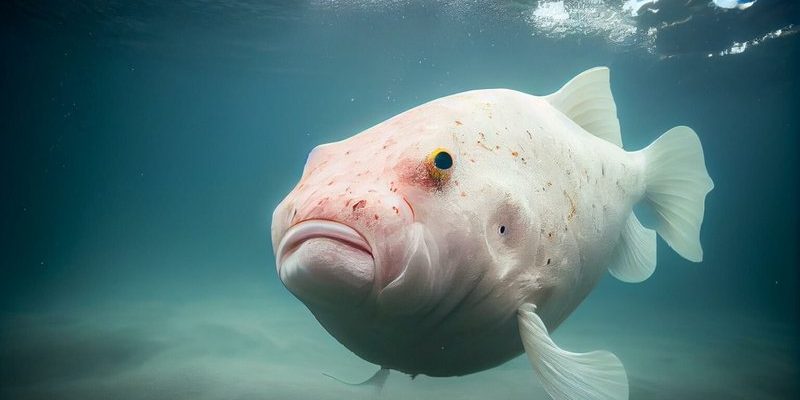
Blobfish might just be one of the most peculiar sea creatures you’ve ever seen. If you picture a fish that looks like it’s made out of jelly or a sad cartoon character, you’re on the right track. This deep-sea fish, scientifically known as Psychedelica marcida, has gained notoriety for its unique appearance, especially when pulled from the deep, pressurized waters it calls home. In its natural environment, the blobfish takes on a form that’s quite different from what we see in pictures. It’s a fascinating example of how creatures can adapt to their environments in such extraordinary ways.
Blobfish inhabit some of the deeper parts of the ocean, primarily off the coasts of Australia and New Zealand. They usually lurk around 2,000 to 4,000 feet below the surface, where the pressure is high and the environment is dark. This is a world that most of us can only imagine, teeming with unique ecosystems and creatures that have adapted to live in such extreme conditions. So, how did this blob-like fish get its rather unflattering reputation? Let’s dive deeper into the life of the blobfish!
Physical Characteristics of Blobfish
The blobfish’s most striking feature is its gelatinous, jelly-like body. It has a somewhat amorphous shape, which can be misleading. When blobfish are in their natural habitat, they actually don’t look like the saggy, sad version often portrayed in photos. Instead, they are more structured, resembling traditional fish with a more streamlined look. This fish has a density that is slightly less than water, allowing it to float effortlessly just above the ocean floor. This adaptation is crucial for conserving energy in an environment where food isn’t always plentiful.
Blobfish typically grow to about 12 inches long, but their size can vary based on their age and environment. Their skin is a pale, almost translucent color, making them blend in with the sandy or rocky ocean floor. Interestingly, their lack of muscle and other physical structures allows them to easily consume food. Blobfish feed primarily on small crustaceans, jellyfish, and other organic materials that drift by, using their large mouths to suck them in as they float along.
Habitat and Distribution
Blobfish are primarily found in the warm waters off the coasts of Australia and New Zealand. They inhabit depths ranging from 2,000 feet (610 meters) to around 4,000 feet (1,220 meters). The pressure at these depths is dramatically higher than what we experience on the surface—so much so that it can be lethal to many other types of fish. This unique habitat provides a safe haven for blobfish, keeping them free from predators. Their preferred environment is generally soft, muddy bottoms where they can easily settle.
As you might imagine, the blobfish’s deep-sea lifestyle makes studying them quite a challenge. Researchers often rely on remotely operated vehicles (ROVs) to explore the depths and observe these fascinating creatures in their natural habitat. Unfortunately, this means that much of what we know about blobfish comes from images and video footage. To truly understand them, conservationists are working hard to preserve their habitats and ensure that these unique fish are not threatened by human activities like deep-sea fishing and oil exploration.
Diet and Feeding Habits
Blobfish are what you might call opportunistic feeders. They don’t chase their meals like some more active fish do. Instead, they wait for food to come to them. Their diet primarily consists of small crustaceans, such as shrimps and crabs, along with other organic materials that drift down from above. With their large mouths, they can easily suck in their food with minimal energy expenditure, which is perfect for their lazy, floating lifestyle.
Interestingly, the blobfish’s feeding strategy is pretty common among deep-sea creatures. In an environment where food can be scarce, being able to consume whatever drifts by can be a matter of survival. Blobfish are not picky eaters, and they will take advantage of whatever nutrients are available. This adaptability plays a crucial role in their survival in the depths of the ocean.
Reproduction and Lifespan
Blobfish have a relatively mysterious reproductive cycle due to the challenges of studying them in their deep-sea habitats. They are believed to reproduce in a similar fashion to many other fish; females likely lay eggs, which the male blobfish then fertilizes. However, specifics about their mating behaviors and gestation periods are still relatively unknown. What we do understand is that blobfish spawn during certain seasons, which can be critical for their populations, particularly given the pressures from environmental threats.
As for their lifespan, blobfish can live for several years, but exact figures are difficult to determine since they are rarely observed in the wild. Some estimates suggest they may live anywhere from 5 to 10 years, but more research is needed to confirm these numbers. Their longevity depends greatly on their environment and how well they can evade predators. Essentially, the fewer threats they face, the better their chances of living a longer life.
Blobfish and Conservation
Unfortunately, blobfish are not immune to the impacts of human activities. Deep-sea fishing practices can inadvertently harm their populations. They often become bycatch, meaning that they are caught unintentionally while other fish are being targeted. This is concerning because blobfish have a slow reproductive rate, making it difficult for their numbers to recover once they are depleted.
Conservationists are advocating for better practices to protect blobfish and other deep-sea species from overfishing and habitat destruction. Protecting their natural environments is crucial for maintaining healthy populations. Education and awareness are also key components in ensuring that blobfish and their ecosystems are preserved for future generations. By understanding and valuing these unique creatures, we can play a part in their protection.
Interesting Facts About Blobfish
| Common Name: | Blobfish |
| Scientific Name: | Psychedelica marcida |
| Habitat: | Deep waters off Australia and New Zealand |
| Average Size: | 12 inches (30 cm) |
| Diet: | Crustaceans and organic material |
| Lifespan: | 5-10 years (estimated) |
FAQ
Are blobfish dangerous to humans?
No, blobfish are not dangerous to humans. They are soft-bodied fish that do not possess any harmful traits or behaviors. In fact, they are rarely seen by people since they live deep underwater, far from human activity. The blobfish prefers to float along the ocean floor, feeding on small critters rather than engaging with anything that poses a threat.
Why do blobfish look sad when they are out of water?
The iconic “sad” appearance of the blobfish comes from the way their bodies respond to changes in pressure. In deep waters, the blobfish’s body is well-suited to its environment, appearing more typical of a fish. But when pulled to the surface, the pressure drops, causing the blobfish’s body to collapse, giving it that droopy, sad look. Underwater, they actually have a somewhat more normal fish-like appearance.
How do blobfish reproduce?
Blobfish reproduce by laying eggs, which the males fertilize. However, not much is known about their exact mating practices or how many eggs they lay at a time. Like many deep-sea fish, their reproductive cycle is not well-documented and is a subject of ongoing research. Conservation efforts are crucial to understanding and protecting their reproduction habits.
Why are blobfish considered endangered?
Blobfish are not officially classified as endangered, but they are vulnerable due to the risks from deep-sea fishing practices. They often become bycatch, which means they are caught unintentionally in nets designed for other fish. Their slow reproductive rates make it difficult for their populations to bounce back, raising concerns about their long-term viability.
What is the blobfish’s primary habitat?
Blobfish primarily inhabit the depths of the ocean off the coasts of Australia and New Zealand, typically lurking at depths of 2,000 to 4,000 feet. This habitat is crucial for their survival, providing both protection and a steady supply of food from drifting organic material.
Can blobfish swim?
Blobfish are not strong swimmers like many other fish. Instead, they use their ability to float just above the ocean floor to conserve energy while they wait for food to come by. Their physical structure allows them to maintain buoyancy without expending much effort, which is particularly useful in the deep-sea environment where they live.
What do blobfish eat?
Blobfish primarily feed on small crustaceans, jellyfish, and other organic matter that drifts by them in the water. They have a unique feeding strategy that allows them to suck in food with minimal energy use, which is perfectly suited to their lazy lifestyle.
How do blobfish fit into the ecosystem?
Blobfish play a role in the deep-sea ecosystem by helping to maintain the balance of small crustacean populations. As opportunistic feeders, they consume drifting organic material, which helps recycle nutrients in their environment. This is an important function for any ecosystem, as it contributes to the overall health and stability of marine life.
Are there other types of blobfish?
While the term “blobfish” commonly refers to Psychedelica marcida, there are other species in the same family, Psychrolutidae, that share similar characteristics. However, the blobfish is the most well-known due to its unique appearance and adaptations to deep-sea life. Further research could uncover more about their relatives, but for now, the blobfish remains a standout!

